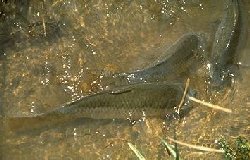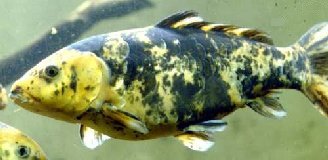Carp
http://www.100md.com
《e Natural Health Center》
 |
 |
 |
Seafood
Carp
Latin:
Cyprinus carpio
Origin:
A hardy fish Cyprinus carpio Linnaeus, of the Cyprinidae family, with different colors: yellow, green, white and red.
Carp is native to Asia but has been introduced into Europe, North America, and elsewhere. A large-scaled fish with two barbels on each side of its upper jaw, the carp lives alone or in small schools in quiet, weedy, mud-bottomed ponds, lakes, and rivers. It is omnivorous, and in rooting about for food it often roils the water, increasing turbidity and adversely affecting many plants and animals. As a result, it is often considered undesirable, and much effort may be devoted to its extermination.
, 百拇医药
In winter the carp becomes torpid, retires to the bottom, and stops feeding. It usually spawns in spring, when the female deposits numerous eggs on plants or detritus, usually in shallow water. The eggs hatch four to eight days later. Carp grow rapidly, attain sexual maturity about the third year, and in captivity may live more than 40 years. They average about 35 cm in length but may grow to more than 100 cm and 22 kg.
The carp is often raised for food, especially in Europe and Asia, because it is possible to produce large amounts of fish per acre. It is a holiday favorite in China and among Eastern European Jews. Two domesticated varieties of the species are the mirror carp (with a few large scales) and the leather carp (almost scaleless). The crucian carp (Carassius carassius) is a barbel-less European relative of the goldfish.
, 百拇医药
Farm-raised carp is available year-round at fish markets.
Also called Red Carp, Common Carp, etc.
Properties:
Sweet in flavor, mild in nature, it is related to the channels of the spleen and kidney.
Functions:
Nourishes the spleen and the stomach, carp keeps the adverse qi flowing downward to benefit digestion, improves milk secretion, induces diuresis (promotes the excretion of urine) to reduce edema, stops coughing.
, 百拇医药
Applications:
Carp is used to treat hydrops (recurrent vertigo accompanied by ringing in the ears and deafness), beriberi (a deficiency disease marked by inflammatory or degenerative changes of the nerves or digestive system), jaundice, cough, and reversed flow of qi.
1. For edema (having abnormally large amounts of fluid in the intercellular tissue spaces of the body) due to hepatic or nephritis (inflammation of the kidney) disorders:
, http://www.100md.com
Treat a 500 g carp as usual and clean it. Pour in 350 ml vinegar and boil with slow fire until vinegar totally evaporated. Eat the carp, once daily.
2. For promoting lactation:
Treat a carp as usual and clean it. Simmer it in water. When half done, add salt and a little vinegar. Eat the fish and drink the soup.
3. For short breath and chronic cough:
Treat a carp in usual way. Clean and cut into small blocks. Fry in oil to brown. Add soybean sauce, sugar, millet wine, and simmer to well done. Place in dish and pour marinade made of vinegar, garlic, chives and ginger onto the fish. Serve as a side dish.
, http://www.100md.com
Dosage and Administration:
Boiled in clear soup or steamed, sweetened and vinegared, boiled in mellow wine and stewed. The secret to successful carp cookery is to not overcook. Whichever of the following cooking methods you choose, your carp will be cooked when the flesh becomes opaque but is still moist on the inside.
Carp is a holiday favorite in China, where it is steamed or poached, and among Eastern European Jews, who use it to make gefilte fish. This fish has a mild flavor but somewhat coarse flesh and is difficult to skin.
, 百拇医药
Carp is available live, fresh, or frozen, either split lengthwise or filleted.
Because carp has large scales that are embedded in the skin, the fish must be skinned. To remove skin, take a sharp knife and cut the skin off in strips, or dip fish in boiling water for 25 seconds, rub the skin off, and cool under running water.
To remove the head, cut through the flesh on both sides with a knife. If the fish is small, slice directly through the spine. For a larger fish, place the knife between vertebrae and tap the back of the knife with a hammer.
, 百拇医药
To fillet, use a sharp, thin knife. With the carp lying on its side, insert the knife behind the gills, and cut in an arc down to just above the backbone. Continue cutting parallel to the backbone toward the tail. Bring the knife up at the tail and remove the fillet.
To make steaks, place the carp on its side. With a sharp knife, cut slices 1.9 to 1.2 cm thick perpendicular to the spine. Tap the back of the blade with a wooden mallet to cut through the spine.
, 百拇医药
Baking: Rinse the fish and pat dry with a paper towel. Place fillet or whole carp in baking pan and cover with sauce made of liquid, herbs and spices, and vegetables. Preheat the oven and bake at 200° C until a knife slice in the thickest part reveals the flesh to be opaque but still moist.
Grilling: Place fillets or steaks directly on perforated aluminum foil, 10 to 15 cm above prepared coals or fire. Baste with butter, oil, or marinade, and close hood of grill. Cook until fish is opaque and moist on the inside, 6 to 8 minutes for fish less than 2.5 cm thick; 10 to 15 minutes for fish larger than 2.5 cm thick.
, 百拇医药
Pan frying: Rinse the carp, and pat dry with a paper towel. Dredge in flour and seasonings. Shake off excess flour. Heat the frying pan until hot, and add butter or oil. Place the fillets in the pan and cook, turning once, until opaque but still moist in the center--2 to 10 minutes, depending upon size of the fish.
Deep frying: Into a wok or deep fryer, pour about 3.8 cm of oil; the cooker should be no more than half full of oil. Heat oil to 190° C, using a thermometer to monitor its temperature. Cut carp into similar sized pieces, about 3 to 3.8 cm thick. Dip in batter, drain, then slip them into the hot oil. Cook until brown, about 2 to 3 minutes.
, 百拇医药
Poaching: Bring poaching liquid, consisting of water, broth, herbs, and spices, to a simmer. Slip in skinless fillets, then cover the pan and keep liquid at a simmer for about 8 minutes per 2.5 cm of thickness.
Broiling: Rinse carp fillets or steaks and pat dry with a paper towel. Coat fish with flour, crumbs, or cornmeal if desired. Place fish on a rack above a baking dish. Preheat broiler and adjust oven rack so fish is 7.6 to 10 cm from the element. Broil, turning once, until fish is opaque but still moist in the center--3 to 10 minutes, depending on size of the fish.
, 百拇医药
Quality carp is easy to recognize. Fresh carp never smells fishy, and the eyes should appear bright and clear, almost alive. The gills should be reddish, and the skin moist and with tightly adhering, shiny scales. Fresh carp flesh will give slightly when you press it with a finger, then springs back into shape. When choosing carp steaks or fillets, whether they are fresh or previously frozen, look for moist, translucent (never dried out) flesh. Keep carp cool on the trip from the market to your house. Never let it stay unrefrigerated for long.
, http://www.100md.com
To store carp, remove packaging, rinse under cold water, and pat dry with paper towels. Fish deteriorates when it sits in its own juices, so place it on a cake rack in a shallow pan filled with crushed ice. Cover with cling wrap or foil and set in the coldest part of the refrigerator. Carp will store well this way for up to two days. When well wrapped, carp can be frozen for up to two months in a refrigerator freezer and for three to four months in a deep-freeze. Use lined freezer paper, and wrap the fish tightly from head to tail with at least two layers of paper.
, http://www.100md.com
To thaw slowly, unwrap the fish, place in pan, cover, and leave for 24 hours in the refrigerator. To thaw faster, place the whole fish (wrapped in a watertight bag) in a sink with cool running water, allowing about 30 minutes per 450 g. For fastest thawing, use the defrost cycle of your microwave, allowing 2 to 5 minutes per 450 g, with equal standing time in between zaps (as one minute defrost to one minute resting).
Cautions on Use:
, 百拇医药
Reference Materials:
Toxic or Side Effects:
Modern Researches:
Carps' chemical composition vary with the places where they grow, the seasons, the environment, the age and the nourishment.
Generally, a carp contains protein, fat, calcium, phosphorus, iron, kinds of amino acid (mainly glutamic acid, glycine, histidine), creatine, creatine phosphate, nicotinic acid, protease, vitamins A, B1, B2 and C. Carp is an excellent source of potassium (726 mg), selenium (27.5 mcg), vitamin B12 (2.5 mcg), and vitamin E (15.3 IU); and a good source of magnesium (64.6 mg).
When cooked (dry heat), carp provides 0.797 grams of omega-3 fatty acids derived from EPA (0.305 g), DHA (0.146 g), and ALA (0.346 g), per 100 grams of carp., 百拇医药